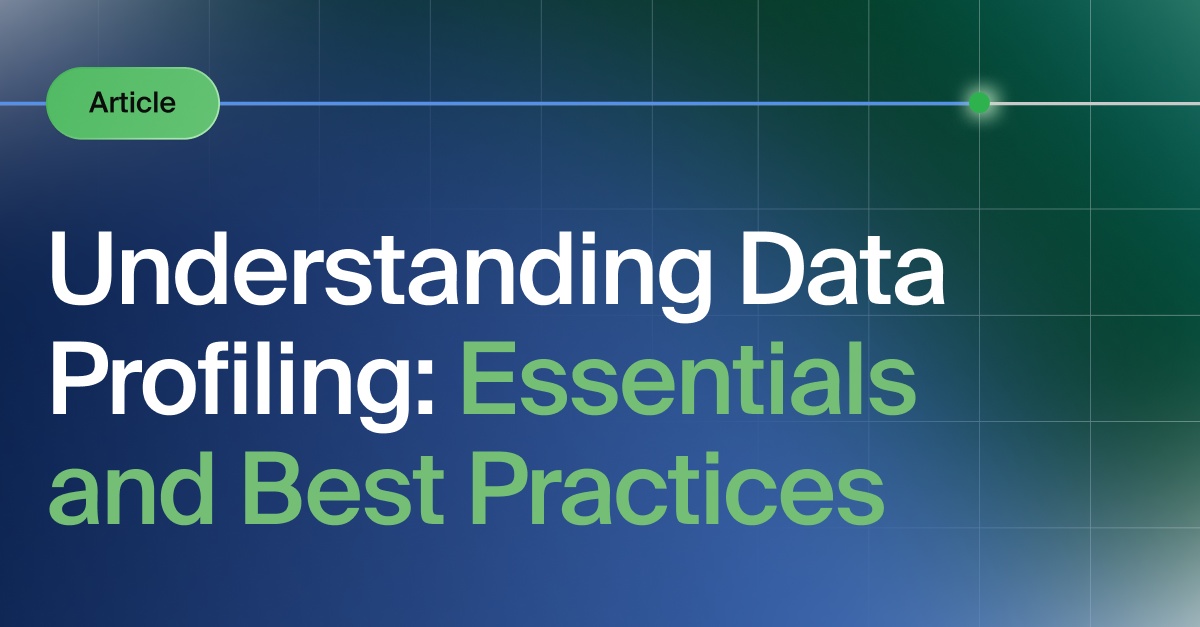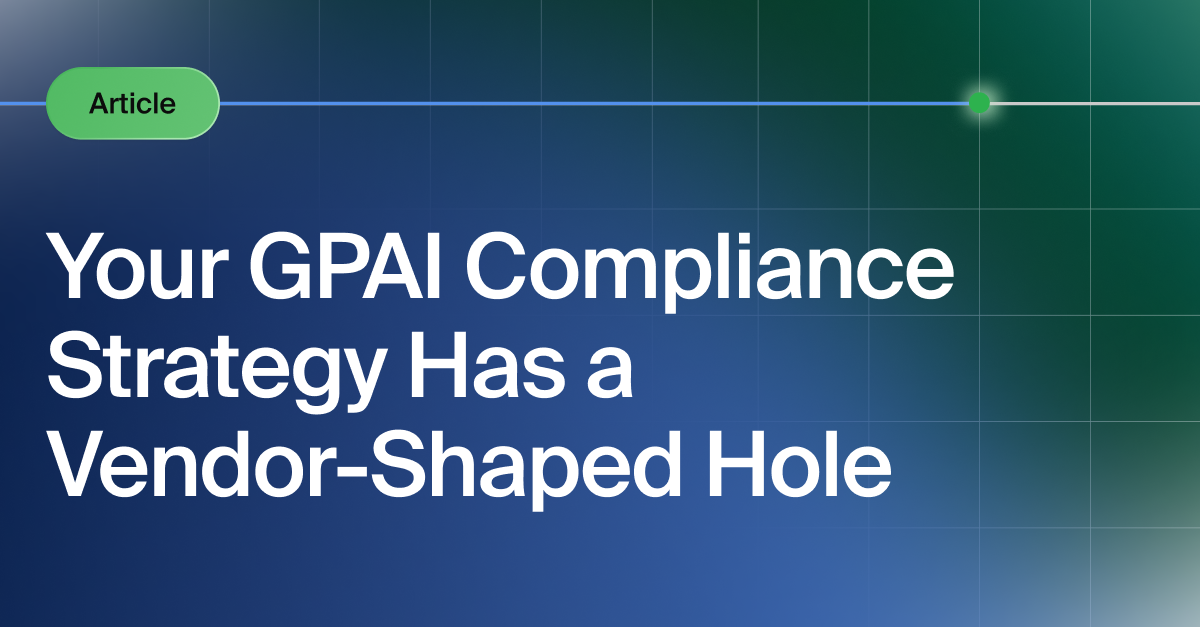Understanding Data Profiling: A Foundation for Better Business Intelligence
TL;DR Data profiling analyzes datasets before use to identify quality issues, patterns, and relationships. It involves three main types: structure discovery (format consistency), content discovery (individual record errors), and relationship discovery (connections between datasets). Key benefits include early issue detection, better monitoring rules, and increased stakeholder trust. Best practices include starting early, automating where possible, focusing on business-relevant metrics, profiling regularly, and collaborating across teams. Tools range from open-source options to enterprise platforms.


Get the Best of Data Leadership
Stay Informed
Get Data Insights Delivered
Data profiling is a longstanding technique for understanding what's inside your datasets. It's long been used in traditional data quality processes, and still plays an essential role in ensuring that business intelligence reports and dashboards stay healthy and reliable.
What is Data Profiling?
In a nutshell, data profiling is scanning a dataset to understand what's inside before you start working with it.
It tells you a basic outline of what values are in each of the columns: min and max values, distribution, most frequent values, duplicates, missing values, etc. It's a core part of traditional data quality work because it helps teams look for issues sitting in the data, which they may want to either resolve and/or write data quality tests for. Profiling is also key to good data observability because it can inform what metrics you should be applying to the dataset to best monitor its behavior over time.
How Does Data Profiling Work?
Data profiling works by querying rows from a dataset (e.g. a random sample of 10,000 rows) and then summarizing what's in each column using a battery of basic statistics. Most tools will check for things like counts of null values, number of distinct values, a list of most frequently occurring values, minimum and maximum values, etc. Some will also look across columns to look for correlations, or across tables to look for referential integrity issues.
Let's say a retail company is preparing for a big marketing campaign and wants to use customer data stored in its data warehouse. Before they dive in, the data team runs profiling on the customer and transactions tables. They find that 12% of the email addresses are missing, and some birthdate values are showing up as future dates. In the transactions table, they spot a few hundred entries where the purchase amount is negative.
Thanks to profiling, the team now knows: (1) that this table probably isn't ready for production use cases, and (2) what kinds of issues they need to resolve before it is. They build a list of issues to fix, then work on the invalid birthdates, filter out the negative purchases, and add some data quality checks to their ETL job to stop the job from completing if these issues are detected. With a cleaner dataset, the campaign is better targeted, and analytics teams can trust the results.
Types of Data Profiling
Data profiling typically falls into three main categories, each serving a specific purpose in understanding and validating your datasets. These approaches work together to provide comprehensive insights into data structure, content quality, and relationships.
Column Distributions
Column distribution analysis examines the statistical properties and patterns within individual data fields to understand their characteristics and quality. This type of profiling generates frequency distributions, identifies outliers, and reveals data patterns that might indicate quality issues or business rules. For example, when profiling a customer age column, you might discover that 15% of records show ages over 150 years old, immediately flagging a data quality issue that needs investigation before the dataset can be trusted for analytics.
Content Discovery
Content discovery involves examining individual data records to identify specific errors, inconsistencies, and systemic issues within the dataset. This approach goes beyond statistical analysis to inspect actual data values and their adherence to expected formats and business rules. A telecommunications company might use content discovery on their customer phone number field and find that some entries contain letters instead of digits, others have inconsistent formatting with varying numbers of digits, revealing data entry problems that could impact customer communications and require standardization rules.
Relationship Discovery
Relationship discovery analyzes connections and dependencies between different datasets, tables, and columns to understand how data elements relate to each other. This process begins with metadata analysis to establish potential relationships, then examines actual data to verify and quantify these connections. For instance, when profiling sales and customer tables, relationship discovery might reveal that 3% of sales records reference customer IDs that don't exist in the customer table, indicating referential integrity issues that need resolution before reliable reporting can occur.
Data Profiling Techniques
Modern data profiling employs various technical approaches to extract meaningful insights from datasets, ranging from single-column analysis to complex cross-table examinations. These techniques work in combination to provide comprehensive data understanding and quality assessment.
Column Profiling
For each column, the profile should tell you about:The distribution of the values: the min, max, average, etc.Missing values: nulls, empty strings, etc.Uniqueness: how many distinct values, how many duplicates.Ideally you get a histogram or other compact data viz that makes it easy to take in the information. MotherDuck has a great implementation of this in their Column Explorer feature!
Image credit: MotherDuck
Cross-Column Profiling
The goal of cross-column analysis is to show the relationships between the columns, or the lack of clear relationship! Sometimes this takes the form of a heatmap, but this example using Seaborn gives more detail because you can see the shape of the relationship in the scatterplots. The diagonal cells show the histogram of values for the given column, and the other cells show the relationship between that column and another column.
Image credit: Python graph Gallery
Relationship discovery
Some data profiling tools can also look across tables to identify potential foreign keys and assess the integrity of a join between the tables. This requires some form of pre-selection of the candidate tables, otherwise the search for table pairings runs into a combinatorial explosion problem.
Benefits of Data Profiling
Because data profiling gives you an upfront look at the shape and quality of your data before it's used for anything important, it helps teams catch issues early, choose the right rules to monitor, and build confidence that the data is ready for use.
Early Issue Detection
First, profiling helps spot data quality problems like missing values, bad formats, or duplicates. By doing this before you start analysis or feed data into downstream systems, you can cut down on surprises later and reduce the risk of bad outputs reaching your stakeholders.
Recommending Rules and Metrics
Second, profiling can suggest what kinds of data quality rules or observability metrics make sense for a dataset based on what's actually going on with the data. If there are occasional nulls in an ID column then you might want a fixed rule to prevent any occurrences at all. If you have varying levels of nulls in the column that records someone's apartment number, you might want a data observability metric instead.
Building Trust
Finally, it creates a paper trail of inspection. When stakeholders know a dataset has been profiled and validated, they're more likely to trust the results and use the data with confidence. For this reason you will want to go beyond profiling to provide a data governance certification, table tag, or other publicly visible indicator that the table has been profiled and all issues have been addressed.
Challenges in Data Profiling
As great as profiling can be, it's not without challenges and limitations. Here are a few things to think about and plan for.
Volume and Variety
Volume refers to the number of rows in a table, and variety refers to the number of columns. Extremely tall, or extremely wide tables present different challenges to data profiling tools. For volume challenges the go-to solution is controlling the sampling method so you aren't pulling 100K+ sets of rows spanning from today to 10 years ago. For variety the tool might need to batch the profiling of the columns so it isn't trying to process 1500 column profiles all at once, but instead do sets of 10 or 20 columns at a time.
Tool Limitations
Every profiler will have some set of checks that it was designed for, and you'll need to rely on that set of checks to validate your data. If there's a condition in your data that the profiler doesn't pick up, you might still have a blind spot.
Interpretation Complexity
Even if your profiler handles really large datasets well, you still have to visualize and consume the information. If the profiler outputs 100s of potential flags about the data, you'll have a long road ahead of you.
Data Silos
You can't profile what you don't know about. If your organization is prone to shadow-IT then you might have some databases or warehouses hiding out in other teams or departments. The good news is: if you're trying to build trust in a centralized set of shared data, you might not want to spend time on those other silos until they have a migration path into the central warehouse. This makes your profiling processes a carrot to offer those teams to play ball with a centralization strategy.
Best Practices in Data Profiling
Implementing effective data profiling requires strategic planning and disciplined execution to maximize value while managing complexity and resource constraints. These proven practices help organizations build sustainable profiling processes that support both immediate data quality needs and long-term data governance objectives.
Start Profiling Early
Begin data profiling at the very start of any data project, before significant time and resources are invested in downstream processing or analysis. Early profiling acts as a quality gate that can prevent costly rework later by identifying fundamental data issues that might require changes to ETL logic, data models, or even project scope. This upfront investment in understanding your data saves exponentially more time and effort than discovering problems after dashboards are built or models are deployed.
Automate Where Possible
Implement automated profiling workflows that can run on schedules or be triggered by data changes, reducing the manual effort required to maintain data quality oversight. Automation ensures consistent profiling standards across datasets and enables proactive detection of data drift or quality degradation over time. However, balance automation with human oversight to interpret results and make decisions about which issues require immediate attention versus those that can be monitored.
Focus on Business-Relevant Metrics
Prioritize profiling efforts on data elements that directly impact business decisions and outcomes, rather than trying to profile every single field comprehensively. Work with business stakeholders to identify which data quality dimensions matter most for their use cases - accuracy might be critical for financial reporting while completeness could be more important for marketing campaigns. This targeted approach ensures profiling efforts deliver maximum business value while keeping resource requirements manageable.
Profile Regularly
Establish regular profiling schedules that align with your data refresh cycles and business reporting needs, treating data profiling as an ongoing process rather than a one-time activity. Data quality can degrade over time due to source system changes, process modifications, or evolving business requirements, making periodic reassessment essential. Regular profiling also helps establish baselines and trends that make it easier to spot anomalies when they occur.
Collaborate Across Teams
Foster collaboration between data engineers, analysts, and business users throughout the profiling process to ensure technical findings translate into actionable business insights. Data engineers can identify technical patterns and anomalies, while business users provide context about what constitutes normal versus problematic data patterns. This cross-functional approach prevents purely technical profiling exercises that miss business-critical quality issues while ensuring that identified problems get addressed with appropriate business priorities.
Data Profiling Tools
The data profiling tool landscape offers solutions ranging from lightweight open-source options to comprehensive enterprise platforms, each designed to meet different organizational needs and technical requirements. Understanding the capabilities and trade-offs of different tool categories helps teams select the right profiling approach for their specific use cases and constraints.
Open Source Tools
Open source data profiling tools provide cost-effective solutions for organizations with technical expertise and specific customization needs. These tools typically include core profiling functions such as pattern detection, duplicate identification, and format validation, making them suitable for small to medium-sized projects or organizations with in-house development capabilities. While they may require manual configuration or scripting for advanced use cases, open source tools offer flexibility and community support that can be valuable for teams with specialized requirements or budget constraints.
Enterprise and Commercial Tools
Enterprise and commercial data profiling tools are designed for large-scale or mission-critical data environments that require advanced capabilities and professional support. These solutions offer integrated data cleansing and transformation features, role-based access controls, and automated profiling with scheduled jobs, along with dashboards and visual reports tailored for non-technical users. They typically include comprehensive documentation, technical support, and integration with broader data governance platforms, making them ideal for organizations that need reliable, scalable solutions and prefer to focus internal resources on business logic rather than tool maintenance.
Cloud-Based Tools
Cloud-based data profiling tools provide hosted solutions that require no on-premises installation and offer scalable, location-independent access to profiling capabilities. These tools are particularly well-suited for organizations with cloud-first data architectures, offering seamless integration with modern data warehouses and analytics platforms while eliminating infrastructure management overhead. Cloud tools often provide elastic scaling to handle varying workloads and include built-in collaboration features that support distributed teams working with shared datasets.
Maintain Data Quality with Bigeye
Modern data teams need more than just profiling - they need comprehensive data observability that turns profiling insights into automated monitoring and alerting systems. Bigeye addresses the key challenges discussed in this article by combining intelligent data profiling with continuous monitoring, helping teams move beyond one-time data assessments to sustained data quality management.
Our platform automatically profiles your datasets to recommend appropriate quality metrics, then monitors those metrics continuously to catch issues before they impact business decisions. Request a demo to see how Bigeye can help your team build trust in your data through intelligent profiling and monitoring.
Monitoring
Schema change detection
Lineage monitoring




.png)
.jpeg)

